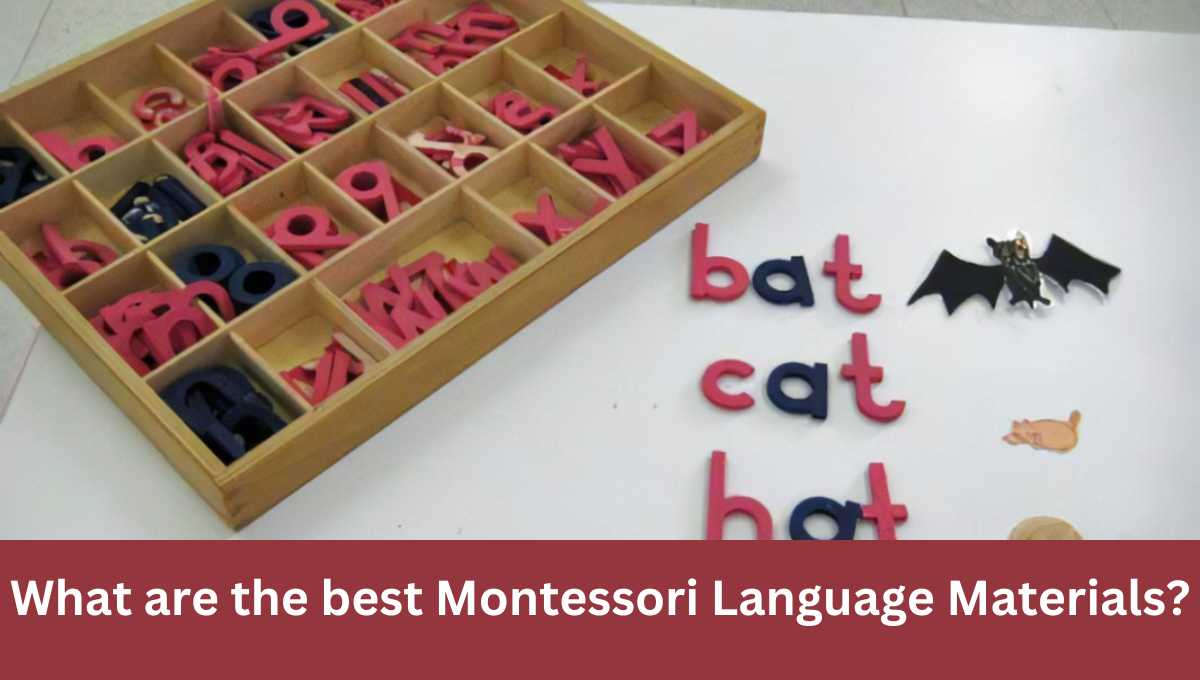What are the best Montessori Language Materials?
Montessori language materials are used to help children naturally learn how to read, write, and speak better. These materials are based on the child’s age and how they’re growing and learning. So, it is difficult to select what are the best Montessori Language Materials? Following are the best content to find out the exact material which are fulfill the everyone’s need.
Introduction to Phonetics
What are Sandpaper Letters?
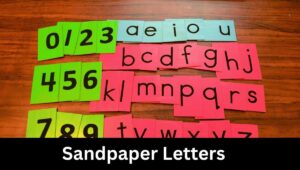
Sandpaper Letters are a set of alphabet letters made of sandpaper material. They are typically designed in both lowercase and uppercase forms. These letters have a rough texture that can be felt when touched.
How Are They Used? Sandpaper Letters are used to teach children the shapes of letters and the sounds they make. Here’s how they are used:
Sensory Experience
Children run their fingers over the sandpaper letters, feeling the texture. This tactile experience helps them remember the shape of each letter.
Phonetic Sound
As they touch each letter, the teacher or parent pronounces the phonetic sound associated with that letter. For example, when touching the letter “b,” the child hears the “b” sound like in “ball.”
Letter Recognition
Over time, children become familiar with the shapes of the letters and the sounds they represent. They start recognizing and associating each letter with its sound.
Why Are They Important? Sandpaper Letters are essential because they provide a hands-on and multisensory approach to learning letters and sounds. This approach helps children in several ways:
Phonetic Awareness
Children develop an understanding of how letters correspond to specific sounds, which is crucial for reading and writing.
Fine Motor Skills
Using their fingers to trace the letters helps children improve their fine motor skills and hand-eye coordination.
Independence
Montessori education encourages independence, and children can use Sandpaper Letters on their own to practice and reinforce their learning.
Building Words and Sentences
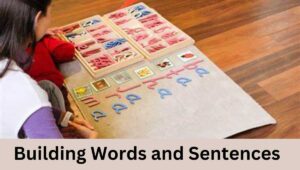
What is the Movable Alphabet? The Movable Alphabet is a set of individual letters, typically made of wood or plastic, that a child can pick up and move around. It’s like having a small box full of letters of the alphabet that you can arrange and rearrange.
How is it Used? Here’s how the Movable Alphabet is used in Montessori education:
Word Building
Children use the Movable Alphabet to build words. They pick up letters and place them in order to spell out words they want to write.
Sentence Making
They can also use it to make sentences. By arranging the letters in the right order, they can create sentences and stories.
Phonetic Practice
The Movable Alphabet is often introduced after children have learned the sounds of the letters using tools like Sandpaper Letters. So, children can practice putting together letters that make specific sounds.
Why is it Important?
The Movable Alphabet is essential for several reasons:
Reading Preparation
It helps children prepare for reading by teaching them how to put letters together to make words.
Writing Practice
It allows children to practice writing before they can actually write with a pencil or any other writing materials. This is important for developing writing skills.
Creativity
Children can use the Movable Alphabet to be creative and make their own words, sentences, and stories. It encourages them to express themselves in writing.
Independence
Like other Montessori materials, the Movable Alphabet encourages independence. Children can use it on their own to practice spelling and writing.
What Are Metal Insets? Metal Insets are a set of metal frames, each containing a different geometric shape cut out of the center. These shapes include squares, triangles, rectangles, and more. Each frame has a small, attached handle for easy use.
How Are They Used? Children use Metal Insets in various creative activities:
Tracing Shapes
They place a piece of paper under the metal inset frame and use a colored pencil to trace around the inside of the shape. This helps them practice controlling their hand movements.
Combining Shapes
Children can use multiple insets to create more complex designs and patterns. For example, they might combine a square and a triangle to make a house shape.
Coloring and Design
After tracing the shapes, children often color them in using different colors to create vibrant and artistic designs.
Why Are They Important? Metal Insets serve several important purposes in a Montessori classroom:
Fine Motor Skills
Using the Metal Insets helps children refine their hand control and dexterity, which is essential for tasks like writing and drawing.
Shape Recognition
By working with these shapes, children become familiar with basic geometric forms, which is foundational for math concepts.
Creativity
The Insets encourage creativity and artistic expression as children use the shapes to make their own designs and patterns.
Concentration
Children often become deeply engaged while working with Metal Insets, which promotes concentration and focus.
Preparation for Handwriting
The control and coordination developed through Metal Insets activities are valuable for preparing children for handwriting skills.
Phonetic Reading Series
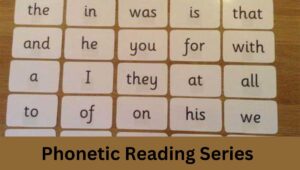
Pink Series
What is the Pink Series? The Pink Series is a collection of simple words that follow basic phonetic rules. These words are typically short and have simple vowel sounds, making them easy for children who are just starting to read.
How is it Used? Teachers or parents introduce these words to children one at a time. The words are often written on pink cards, hence the name. Children learn to read these words by sounding out each letter and blending them together.
Purpose
The Pink Series helps children build a strong foundation in reading. It introduces them to the concept of sounding out letters to read words, which is a crucial step in learning to read.
Blue Series
What is the Blue Series? The Blue Series is a bit more advanced than the Pink Series. It includes words that follow phonetic rules but are slightly longer and more complex. These words may have consonant blends (like “bl” in “blue”) and introduce children to different vowel combinations.
How is it Used? Similar to the Pink Series, children work with blue cards containing these words. They continue to practice sounding out the letters but also learn to handle more complex phonetic patterns.
Purpose
The Blue Series builds on the foundation laid by the Pink Series. It helps children become more proficient readers by introducing them to longer and slightly more challenging words.
Green Series
What is the Green Series? The Green Series takes reading to the next level. It includes words that may not follow the typical phonetic rules. Some of the words in this series are not phonetic, which means they can’t be sounded out letter by letter.
How is it Used? Children work with green cards that contain these words. They learn to recognize and read these words by sight, rather than relying solely on phonics.
Purpose
The Green Series prepares children for more complex reading. It introduces them to words that can’t be sounded out easily, encouraging them to develop sight recognition, a key skill for fluent reading.
What Are Advanced Language Materials?
Advanced Language Materials are a set of Montessori materials that aim to deepen a child’s understanding of language and grammar. They go beyond basic reading and writing and introduce more complex language concepts. These materials are typically used with older children who have already mastered the fundamentals of reading and writing.
Examples of Advanced Language Materials:
Grammar Boxes
These are sets of cards and boxes that help children explore the structure of sentences and the parts of speech (like nouns, verbs, adjectives, etc.). Each card represents a word, and children use these cards to build and analyze sentences, gaining a better understanding of sentence structure and grammar rules.
Grammar Symbols
These are special symbols or shapes that represent different parts of speech (like a triangle for nouns, a circle for verbs, and so on). Children use these symbols along with grammar boxes to visually represent the structure of sentences. This visual aid helps them grasp complex grammar concepts.
Sentence Analysis
Sentence analysis materials include charts and labels that help children break down complex sentences into their grammatical components. This helps them understand how different parts of speech fit together in sentences.
Why Are They Important?
Advanced Language Materials are important because they:
Deepen Language Understanding
These materials take a child’s language skills to a higher level by teaching them about grammar rules and more sophisticated sentence structures.
Enhance Communication
As children become more familiar with advanced language concepts, they can express themselves more precisely and effectively in both spoken and written language.
Preparation for Advanced Reading and Writing
Understanding grammar and sentence structure is essential for comprehending and creating more complex texts.
Cognitive Development
Working with these materials stimulates cognitive development by challenging children to analyze and manipulate language in more intricate ways.
Reading and Comprehension
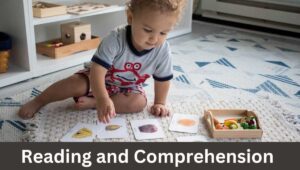
Reading:
What Is Reading? Reading is the process of looking at words and understanding what they mean. It’s like decoding a secret message hidden in the letters of a word.
How Do We Learn to Read? In Montessori, children start by learning the sounds of letters using tools like Sandpaper Letters. They also use the Movable Alphabet to put letters together to make words. Gradually, they learn to recognize and read words on their own.
Comprehension:
What Is Comprehension? Comprehension is understanding what you read. It’s not just about saying the words correctly but also knowing what they mean and what the text is trying to tell you.
How Do We Learn Comprehension? In Montessori, children learn comprehension by discussing what they read. They talk about the story or text, answer questions about it, and even act out scenes. This helps them understand the meaning and remember the information better.
Why Are Reading and Comprehension Important? Reading and comprehension are important because they open up a whole world of knowledge and imagination. When you can read and understand what you read, you can learn about new things, enjoy stories, and communicate better with others.
Montessori Approach to Reading and Comprehension: Montessori educators use a variety of materials and activities to teach reading and comprehension, starting with simple words and gradually moving to more complex texts. The focus is on helping each child progress at their own pace and develop a love for reading and learning.
Spelling and Vocabulary
Spelling:
What Is Spelling? Spelling is the skill of writing words correctly by putting the right letters in the right order. It’s like putting together the pieces of a puzzle to create words.
How Do We Learn to Spell? In Montessori education, children often start by learning the sounds of letters and using tools like the Movable Alphabet to spell out words. They practice putting letters together to create words, and over time, they learn to spell more and more words correctly.
Why Is Spelling Important? Spelling is important because it helps us write and communicate clearly. When we spell words correctly, others can understand what we’re trying to say. It’s like having the right keys to open a door.
Vocabulary:
What Is Vocabulary? Vocabulary is all the words you know and understand. It’s like a big collection of words in your brain that you can use to express yourself.
How Do We Learn Vocabulary? In Montessori, children learn vocabulary by being exposed to a variety of words in their reading materials, conversations, and educational activities. They also engage in activities that help them understand the meaning of words and how to use them in sentences.
Why Is Vocabulary Important? Vocabulary is important because it allows us to communicate effectively. The more words we know, the better we can express our thoughts, ideas, and feelings. It’s like having a colorful palette of paints to create beautiful pictures with words.
Montessori Approach to Spelling and Vocabulary: Montessori educators provide a rich language environment where children are encouraged to explore words, their meanings, and how they are spelled. They use a variety of materials and activities to make learning spelling and vocabulary fun and engaging.
Dictionary and Reference Materials
What Is a Dictionary and Reference Materials?
A dictionary is like a special book that has a list of words in it. Each word in the dictionary is explained with its meaning and how to say it. Reference materials are things like dictionaries, encyclopedias, and other books or websites you can use to learn more about different topics, not just words.
How Do We Use Dictionaries and Reference Materials?
Using a dictionary is easy. When you come across a word you don’t know or want to understand better, you look it up in the dictionary. You find the word’s meaning, how to say it, and sometimes examples of how to use it in sentences.
For example, if you find the word “brilliant” and want to know what it means, you can look it up in the dictionary, and it will tell you that “brilliant” means very smart or very bright.
Why Are Dictionaries and Reference Materials Important?
Dictionaries and reference materials are important because they help you:
Understand Words
They explain what words mean, so you can use them correctly in writing and conversation.
Improve Communication
Knowing the meanings of words makes you a better communicator because you can express your thoughts and ideas more clearly.
Learn About the World
Reference materials like encyclopedias can give you information about all sorts of topics, from history and science to famous people and places.
Solve Problems
When you’re stuck on a word or need to find information, dictionaries and reference materials are like your helpful guides.
